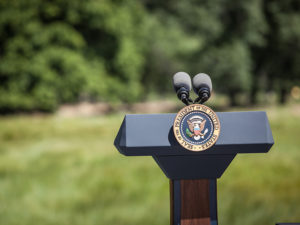Hard News Tie-Ins: The Right Way, The Wrong Way
Here are two press releases from two different NGOs responding to the same major news event (and the graphic that one of them included). I’m giving you the headline and first paragraph, and a link in each headline to read the whole thing—and then I’ll dissect them for you. Neither of these is a client and I had nothing to do with writing them—so this is purely about the lessons we can draw.
Example #1:

BSR regrets today’s executive order from U.S. President Donald Trump to dismantle the Clean Power Plan, a set of U.S. Environmental Protection Agency (EPA) policies that are intended to reduce the United States’ greenhouse gas emissions by 32 percent from 2005 levels and cut carbon pollution from the power sector by 30 percent by 2030. In combination with the administration’s dramatic cuts to climate programs at the EPA and U.S. State Department, this announcement undermines policies that have stimulated economic growth, consumer savings, job creation, infrastructure investment, private-sector competitiveness, and public health.
Example #2:
Which did you find more effective?
Ask yourself just two questions: which worked better for you, and why? Then scroll down to see what I felt worked well and poorly about each.
If you’d like me to include your results in a summary (you won’t be identified), please drop me a note with your answers.
Shel’s Analysis:
While the BSR release did a better job understanding the need for rich content, with numerous links and a picture, the copy was pathetically weak. This press release:
- Used a wimpy headline that doesn’t take a position
- Chose a stock photo that doesn’t add anything to the reader’s understanding—why not a photo of demonstrators thanking a company for providing clean energy and good jobs?
- Made a terrible verb choice in “regrets”—which makes it sound like an accident that was BSR’s faults—rather than a much more appropriate verb, like “condemns”
- Buried the real story in the second paragraph, which has hard-hitting facts to make a clear case against the Executive Order:
Just 18 months ago, the U.S. federal government estimated the net economic benefits of the CPP at US$26-45 billion, with consumers set to save US$155 billion from 2020 to 2030. In addition, the CPP provides regulatory support to the clean energy economy, which, according to the U.S. Department of Energy’s Energy and Employment Report, supported more than 3 million U.S. jobs in 2016. The public health benefits are also significant. Research suggests the Clean Power Plan could prevent 3,600 premature deaths and more than 300,000 missed work and school days by cutting pollutants that contribute to soot and smog. – See more at: https://3blmedia.com/News/BSRs-Statement-US-Administration-Executive-Order-Climate-Change#sthash.qUNCeiiF.dpuf
- The release itself is pretty much all rhetoric, without the facts to back it up. BSR had the facts, but didn’t call attention to them.
- There’s no link to Lubber’s complete statement (and only two links in the whole release).
- The important point about losing competitive advantage to China is all the way down at the bottom of the release.
- No graphics at all.

